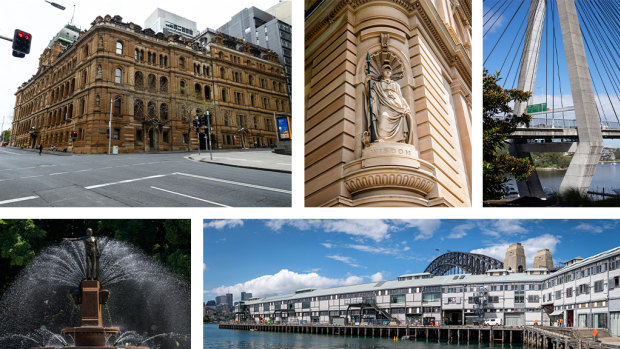Nine out of 10 NSW heritage sites lack a condition rating

Save articles for later
Add articles to your saved list and come back to them any time.
The state’s heritage watchdog has been portrayed as weak and largely ineffective in a damning audit which found it had taken up to 17 years to assess properties for protection, and its records are so poor it knows little about the true physical condition of hundreds of historic properties in its inventory.
The NSW Auditor General found systemic failures and huge information gaps in its databases had left Heritage NSW with “low visibility” and inadequate oversight of more than 1700 items on the state’s heritage register, with the body using its enforcement powers infrequently.
Heritage listing provides formal legal protection for exceptional and rare examples of 19th and 20th-century buildings, Aboriginal massacre or sacred cultural sites, schools, war memorials, shipwrecks, bridges, and gardens.
Some of the state heritage listed properties under care of Heritage NSW.Credit: SMH Graphics
Half of these properties are owned by government; the rest are managed by private owners and councils.
Assessments of properties for listing, protecting them from redevelopment or demolition, can take anywhere from three months to 17 years to complete, or about five years on average. The audit did find that significant improvements in the turnaround of applications for major works on heritage items had been made in the past 18 months and delivered timely advice on heritage impacts in 90 per cent of cases.
Once the items are on the register, Heritage NSW lacked even the most basic information to assess the condition or risk of damage and disrepair to heritage-listed state jewels, let alone ensure compliance or detect potential breaches.
Almost 90 per cent of items (1583) on the register did not include a physical condition rating. Thirty-five per cent (625) lacked any detailed physical description at all making pursuit of any breaches difficult. Twelve per cent of records did not contain a statement outlining why the property was significant in the first place.
Only 9 per cent of listing records had been updated in the past eight years, and only 24 in the last three years. That meant the body had limited means to check for unauthorised development or detect breaches. Most of its publications had not been updated in 10 years, and some not updated in more than 20 years.
Further, Heritage NSW did not necessarily have up-to-date contacts to reach owners to encourage compliance, and lacked processes to identify ownership changes. Its focus on improving customer service to owners and managers risked its capacity to oversee listed properties and support heritage values.
Sitting within the Department of Planning and Environment, Heritage NSW provides professional advice and administrative support to the Heritage Council to protect, conserve, manage, and celebrate heritage places across NSW.
But its “low visibility” limited its capacity to monitor the condition of the state’s heritage assets, the audit found. Heritage NSW did not conduct routine inspections or make site visits to check on the condition of historic buildings for compliance, and did not routinely collect and update information on the condition of registered properties.
It had not issued stop-work orders to remedy or restrict harm in any of its investigations between 2019 and 2022. A stop-work order for the Ryde Civic Centre was revoked 11 days later on Heritage NSW’s own advice.
In one case seven years ago, one unnamed state entity intentionally demolished a listed building while under investigation for demolishing another.
New heritage minister Penny Sharpe said it was clear there was a “lot to fix when it comes to heritage in our state” and blamed the agency’s failings on chronic underfunding over 12 years and a lack of interest in heritage by the previous government.
“Heritage has accepted the findings of the report,” she said. “The NSW Government made an election commitment to implement reforms to the Heritage Act as part of the development of a heritage strategy. Any change in legislation regarding compliance and enforcement will be part of that process.”
Sharpe also said a pilot grants project, Heritage PitchFest, which she and other critics have described as a heritage “hunger games”, would not be repeated while an evaluation was underway.
The audit office found probity issues and the online platform used to collect public votes for the $1 million grants competition was potentially open to multiple voting and votes by those with a conflict of interest.
Heritage NSW accepted the audit office’s eight recommendations, including a clean-up of its databases by June 2024, and said changes and improvements to processes were already under way. Strong progress on new heritage laws had been made; it had rolled out a Blue Plaque program and approved 89 items for the heritage register in six years.
“Heritage NSW accepts all audit recommendations and has commenced work to implement them,” a spokesperson said. “Heritage NSW has made a number of significant achievements. The activating state heritage grant [PitchFest] was a pilot program in the 2023-25 grant funds. It is not an annual program. The grant category is being evaluated and that will inform future investment in the next funding round.”
The findings come a year after the National Trust accused the Education Department, one of the largest owners of protected buildings, of having a lax attitude toward heritage. The audit found many government departments kept incomplete registers of their heritage assets and half had not responded to Heritage NSW’s recent check-up document.
Suzette Meade, from the North Parramatta Residents’ Action Group, said any new heritage strategy needed to also look at the make-up of the sister Heritage Council and its listing committee. “Any new changes in NSW heritage policy can’t be progressed in a silo; it’s imperative that NSW planning legislation is reviewed in unison,” she said.
“The DA for Parramatta’s light rail through the North Parramatta heritage precinct seemed to have been expedited compared to the lag in getting the Parramatta Female Factory nominated for UNESCO World Heritage listing.”
Former trustee of the Powerhouse Museum Kylie Winkworth said governments should be model owners of heritage places.
Instead, she said government had “turned a blind eye to heritage risks, delisted heritage items owned by government entities, and in the case of the Powerhouse Museum confected a partial listing – opposed by the eminent museum and heritage experts – to facilitate the wasteful demolition of a Sulman award-winning museum”.
The Morning Edition newsletter is our guide to the day’s most important and interesting stories, analysis and insights. Sign up here.
